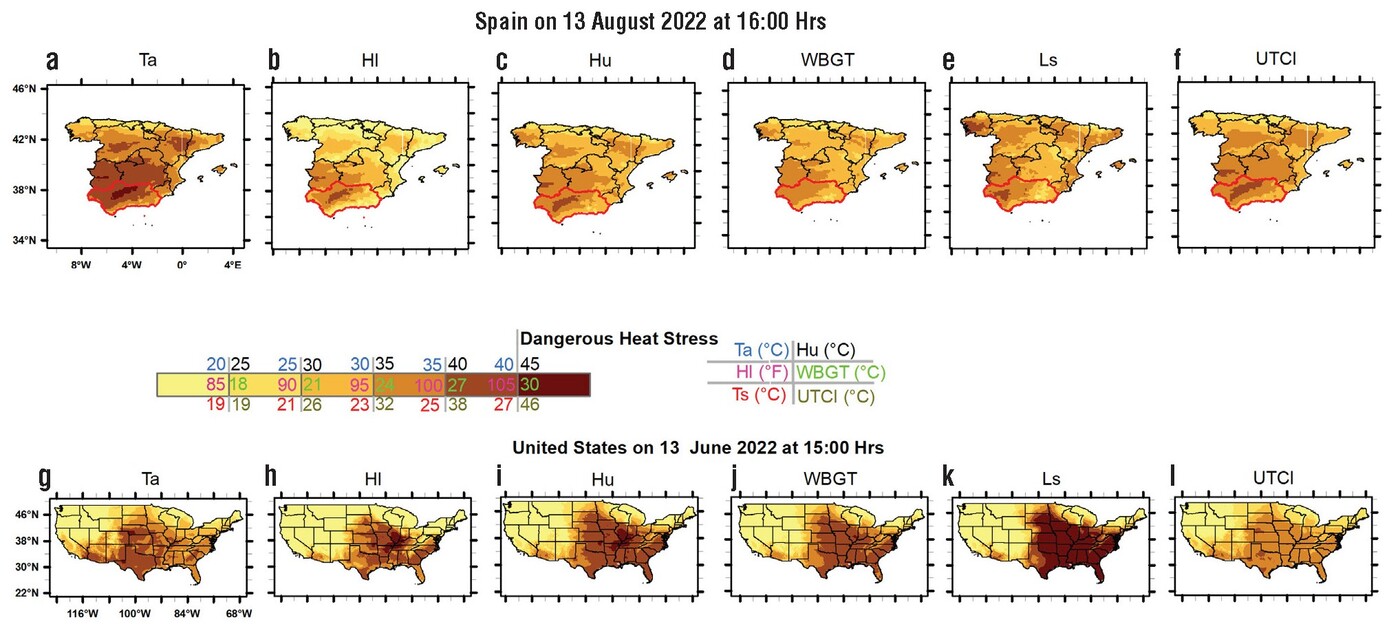Confronting a Warming World: An Urgent Need for a Standardised Heatwave Index

A Comparative Analysis of Six Existing Heatwave Indices
Study conducted by Prof. Qihao WENG and his research team

Heatwaves have emerged as one of the most significant climate-related hazards of the 21st century, with projections indicating that their frequency, intensity and duration will all escalate as global temperatures continue to rise. Defined as prolonged periods of abnormally warm conditions, heatwaves are responsible for thousands of deaths each year and pose significant risks to public health, infrastructure and economies. The Intergovernmental Panel on Climate Change has repeatedly highlighted the growing threat of heatwaves in the context of anthropogenic climate change, noting that urbanisation and global warming are amplifying their impacts, particularly in densely populated and vulnerable regions.
Despite the present danger posed by heatwaves, the scientific community continues to grapple with the challenge of accurately identifying and characterising dangerous heatwave conditions that impact workers who spend substantial time outdoors, such as construction workers and agricultural labourers. Traditional methods for detecting heatwaves often rely on temperature thresholds that may not fully capture the complex interplay between temperature, humidity and other meteorological factors that determine human heat stress. As climate patterns shift and extreme events become more common, there is an urgent need to revisit and refine the threshold for identifying dangerous heatwave conditions. Additionally, developing new heat-wave indices could better detect and assess heatwave risks. A research team led by Prof. Qihao WENG, Chair Professor of Geomatics and Artificial Intelligence in the Department of Land Surveying and Geo-Informatics and Director of the Research Centre for Artificial Intelligence in Geomatics at The Hong Kong Polytechnic University, has studied six commonly used existing heat-wave indices and urged the scientific community to develop a new framework for a standardised heat-wave index prediction and early warning system in Nexus [1]. The establishment of a standardised index has direct implications for public health warnings, policy interventions, and the development of effective mitigation strategies.
There are two primary approaches employed to detect heatwaves. The climatic approach relies on measuring near-surface maximum air temperature, making it simple and widely used, but it overlooks the crucial roles of humidity, wind and radiation in human heat stress. The physiological approach addresses this by incorporating variables such as humidity, which can significantly increase heat risk even at lower temperatures, especially for outdoor workers. The latter approach better reflects the combined environmental factors that impact health during extreme heatwave conditions.
In light of these considerations, the research team undertook a comprehensive comparison of six widely used heatwave indices, with the aim of evaluating their effectiveness in identifying dangerous outdoor heatwave conditions across diverse climatic and geographic contexts. The six indices examined are: maximum air temperature (Ta), Steadman’s heat index (HI) [2], humidex (Hu) [3], wet bulb globe temperature (WBGT) [4], lethal heat stress index (Ls) [5] and the universal thermal climate index (UTCI) [6]. Each of these indices is derived from different combinations of meteorological variables and has been adopted in various national and international frameworks for heatwave detection.
Maximum air temperature (Ta) is the simplest of the indices, relying solely on ambient temperature. While it provides a useful baseline, it does not account for the modifying effects of humidity or other factors. The heat index (HI) combines air temperature and relative humidity to estimate the perceived temperature experienced by humans. Humidex (Hu) is similarly based on air temperature and dew point temperature, offering another measure of perceived heat stress. The wet bulb globe temperature (WBGT) incorporates wet bulb temperatureNote1 and air temperature, and is commonly used in occupational health and sports settings to assess heat risk. The lethal heat stress index (Ls), a more recent development, builds on the wet bulb temperature but includes a correction for humidity, making it particularly sensitive to low-humidity conditions. Finally, the universal thermal climate index (UTCI) is a sophisticated model that integrates air temperature, humidity, wind speed and radiation to provide a comprehensive assessment of thermal stress.
Figure 1. Spatial variation in the six heatwave indices
a-f) The case of Southern Asia on 23 May, 2023
g-l) The case of West Bengal, India on 10 April, 2023
m-r) The case of Uttar Pradesh, India on 23 May, 2023
To evaluate the performance of these indices, the study analysed recent heatwave events in Asia, Europe and the United States, with a particular focus on the unprecedented 2023 heatwave in Southern Asia. Figure 1 illustrates the spatial and temporal distribution of dangerous heatwave conditions (Figure 1a-f) during the 2023 heatwave. This region, home to some of the world’s most densely populated and climate-vulnerable communities, experienced record-breaking temperatures and widespread reports of heat-related mortality. In India, for example, the states of West Bengal and Uttar Pradesh faced particularly severe impacts, including power outages and school closures, which led to public protests as daily maximum temperatures exceeded 45°C in some areas and humidity levels compounded the risk of heat stress. The research team applied all six indices to map the spatial extent of dangerous heatwave conditions during these events (Figure 1g-r).
The findings reveal significant disparities in the ability of different indices to detect dangerous heatwave days, particularly under low-humidity conditions. Ls consistently outperformed the other indices in identifying dangerous heatwave effected regions and days with high heat-related mortality and morbidity. In the case of West Bengal, for instance, Ls was able to demarcate dangerous heatwave conditions across multiple districts, aligning closely with media reports and official warnings from the Indian Meteorological Department. In contrast, other indices such as HI, Hu, WBGT and UTCI either underestimated or failed to capture the full extent of the risk, especially in areas where humidity was below 30%. Similarly, in Uttar Pradesh, Ls identified a greater number of dangerous heatwave days than the other indices, providing a more accurate reflection of the observed health impacts and public distress.


Figure 2. Spatial variation in the six heatwave indices
a-f) The case of Spain on 13 August, 2022
g-l) The case of United States on 13 June, 2022
While the focus of the current study was on Asia, the results from Europe and the United States further underscore the limitations of traditional heatwave indices. During the 2022 heatwave in Spain, for example, the Ls and UTCI indices were the only ones to indicate dangerous heatwave conditions, despite relatively moderate maximum temperatures, in the most effected Andalusia region of Spain (Figure 2a-f). In the United States, the June 2022 heatwave saw the Ls index reveal a deadly heatwave situation that was not adequately captured by the other indices (Figure 2g-l). These findings highlight the importance of selecting an appropriate index for heatwave detection, tailored to the specific climatic and meteorological context.
The study demonstrates that the choice of heatwave index has profound implications for the identification and management of dangerous heatwave conditions. The lethal heat stress index (Ls), with its sensitivity to both temperature and humidity, after applying necessary humidity correction to wet bulb temperature, offers a significant improvement over traditional indices, particularly in low-humidity environments.
As global warming accelerates and heatwaves become more frequent and severe, there is an urgent need for the development of a standardised, globally applicable framework for heatwave detection and early warning. Such a framework should be informed by physiological data, validated against real-world health outcomes and adaptable to the diverse climatic realities faced by communities around the world. Only through interdisciplinary collaboration and the adoption of robust, evidence-based indices can we hope to mitigate the growing threat of heatwaves in a changing climate.
The research is financially supported by a Global STEM Professorship of Hong Kong SAR Government (P0039329), the Research Talent Hub of the Innovation and Technology Fund of Hong Kong (P0039329), and The Hong Kong Polytechnic University (P0046482 and P0038446).
Prof. Weng was ranked among the top 2% most-cited scientists worldwide (career-long) by Stanford University in the field of Geological and Geomatics Engineering for six consecutive years, from 2019 to 2024, and was ranked among the top 2% most-cited scientists worldwide (single-year) for six consecutive years, from 2019 to 2024. He was also named as the John R. Jensen Distinguished Lecturer in 2021, and received the AAG Wilbanks Prize for Transformational Research in Geography in 2024 and Lifetime Achievement in Remote Sensing Award in the same year.
| Notes |
|---|
The wet bulb temperature is the lowest temperature that can be reached by evaporative cooling. It is always lower than the air temperature due to the cooling effect of evaporation.
| References |
|---|
[1] Mohammad, P., Weng, Q. (2024). Comparing existing heatwave indices in identifying dangerous heatwave outdoor conditions. Nexus, Volume 1, Issue 3, 100027, September 2024.
[2] Rothfusz, L.P. (1990). The heat index “equation” (or, more than you ever wanted to know about heat index). https://www.weather.gov/media/ffc/ta_htindx.PDF.
[3] Humidex rating (2009). Canadian Centre for Occupational Health and Safety. https://www.ccohs.ca/oshanswers/phys_agents/humidex.html.
[4] Vecellio, D.J., Wolf, S.T., Cottle, R.M., et al. (2022). Utility of the Heat Index in defining the upper limits of thermal balance during light physical activity (PSU HEAT Project). Int. J. Biometeorol. 66, 1759-1769.
[5] Wouters, H., Keune, J., Petrova, I.Y., et al. (2022). Soil drought can mitigate deadly heat stress thanks to a reduction of air humidity. Science Advances 8, eabe6653.
[6] Bröde, P., Fiala, D., B1a_ zejczyk, K., et al. (2012). Deriving the operational procedure for the Universal Thermal Climate Index (UTCI). Int. J. Biometeorol. 56, 481-494.
 | Prof. Qihao WENG |




